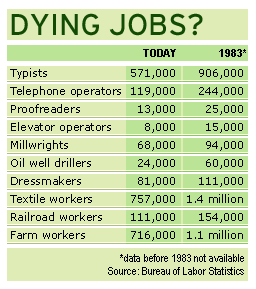New York (CNN/Money) � At Hoover's Dairy Farm, in Sanborn, N.Y., they still deliver milk the old-fashioned way: in glass bottles dropped off door-to-door.
| More on jobs
|

|
|
|
|
Edwin Hoover opened his farm back in 1920 and it's now run by the fifth generation of the family: Robert, his wife, Julie, and their sons, Rob and Tom.
The farm's refrigerated red-and-white milk trucks have long been a familiar sight throughout Niagara County, making rounds to about 1,800 customers.
"Some of the older people still have milk boxes attached to their homes. We also have keys to people's home so we'll leave the milk right in the fridge or in the garage to keep cool," says Julie.
It wasn't so very long ago that the delivery of fresh milk was a common event. Now, the number of milkmen making door-to-door rounds can probably be counted "on one hand," surmises Julie. "We've hung in there."
Economists call the permanent demise of certain jobs a "structural" loss because their absence changes the shape and texture of the current labor market. These days, more and more individuals are working in jobs that are disappearing from the American landscape.

In fact, the nation's current work force is now undergoing the most profound structural change since World War II, says Erica L. Groshen, a labor economist at the Federal Reserve Bank of New York.
Groshen recently co-authored a study looking at today's permanent job losses that have mounted even as the economy recovers. The findings? A full 79 percent of U.S. jobs are in "structurally" changed professions, where employers have permanently eliminated jobs they won't ever refill.
Instead, they are changing the way they do business, and the kind of employees they hire.
"As farms became more and more productive, that released more labor to work in cities and in manufacturing," says Groshen. "As manufacturing became more productive, that released people to work in the service sector."
The economist cites globalization as a factor in the evolution of the American work force.
"As we trade, we release more labor from the service sector because our highly skilled and highly paid workers lose their competitive advantage," she observes. "So we go on to the next big thing. We specialize in innovation. We start new products and industries."
Fishing on decline
Economists call the permanent demise of certain jobs a "structural" loss because their absence changes the shape and texture of the current labor market. And these days during the so-called "jobless recovery" there are more and more individuals who - while not necessarily employed in "old fashioned" jobs like the Hoovers - are nevertheless working in jobs that are quickly disappearing from the American landscape.
At one point, abundant supplies of these ground fish supplied a livelihood for fishermen and fueled development up and down New England's coastline into Canada.
But today the federal government strictly regulates the ground fish industry because of overfishing. Quotas set strict limits on when and where fishermen can fish and federal money has paid to take boats out of circulation.
"The feeling now is that fewer people are fishing nationwide because of the regulations," says Phil Logan, an economist at Northeast Fishery Science Center in Woods Hole, Mass.
It's impossible to know how many fishermen have quit the trade, says Logan, because no one has yet done a comprehensive study. Some fishermen have kept working by catching lobster and scallops instead. Others have simply hung up their nets for good.
Living history
There are those who look for less tangible rewards from old-fashioned work: a sense of pride in their work, for instance, or a feeling of being part of living history.
That's the case with Chuck Russell-Coons, one of the elevator operators at Seattle's historic Smith Tower. The tower boasts seven lifts run by elevator operators who ferry passengers up and down 35 floors, just as they have ever since the building was built back in 1914.
In those days plenty of office buildings and stores had elevator operators manually operating the lifts. Those who knew them tend to miss the good old days, says Russell-Coons.
"Generally older folks had fond remembrances of elevator operators from 20 or 30 years ago. They'd say things like, 'I remember the operator at such-and-such department store used to have candy for the kids,'" says Russell-Coons. "You do have a sense that you're a bridge from the past to the current, a keeper of tradition."
The show goes on
Tradition is also alive and well in Mountain View, Ark. That's where Bobby Tompson runs the Stone Drive-In movie theater that his father started nearly four decades ago.
It began when Tompson's father came home one day with a used Ford truck, small popcorn machine and two movie projectors. He drove the Ford throughout Arkansas, stopping in towns to sell tickets to films that he projected on the sides of churches and school buildings.
Eventually, Tompson's dad erected a permanent giant movie screen in a field near their home, installed speaker stands, a tiny ticket booth and concession stand. Tompson took over after his father's death, and he still runs the movies during summer nights.
From his perch in the ticket booth (his wife, Christy, runs the concession stand and flips the switch on the projector), Tompson has witnessed a lot of change.
Most significantly, drive-in movies are on the list of endangered jobs. Today there are 401 operational drive-in theaters. Back in the late 1950's, there were more than 4,000, according to United Drive-In Theaters Owners Association.
"In the old days, if you had a movie a month after it came out you were doing pretty good," says Tompson, who ended the 2003 season with the "The Matrix: Revolutions." "Now people want it in a week."
As for the Stone's future? Tompson's own kids don't have much interest in the big screen. They earn their livings programming computers and selling jewelry on the Internet.

|

